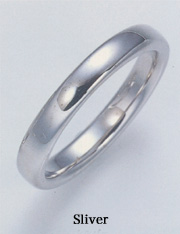RHODIUM PLATING
Brooches must be lightweight, yet made with consideration for durability. As a while metal, 950 platinum is a standard, but if weight poses a problem with how the piece wears, 750 white gold (18K) will be chosen.
White gold is gold that has been alloyed with either palladium or silver. Though it is called white, the base metal is gold, so even if it is alloyed, a degree of yellowish color remains. Because of this, almost all white gold jewelry is plated with rhodium. Under normal conditions, the plating will not come off. When put under a jeweler’s torch during repairs, however, the underlying yellowish color is exposed, making replating necessary each time the piece is repaired. Yellow gold can also be changed to a totally white color by plating, but drastically changing a metal’s color by plating is not appropriate for fine jewelry.
As the photograph to the right show, platinum, white gold, and silver each have a characteristic color, but all have the same color after rhodium plating. The original colors of platinum and silver jewelry should be taken advantage of as they are. As far as white gold jewelry is concerned, customers should clearly be told that it is plated with rhodium, so that they can understand why this is done. |
 |
|
 |
| Rhodium-Plated Color |
 |
 |
 |
| Quality Sample Only |
|
 |
|